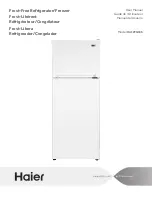
Electrical Maintenance
44
•
Make sure the drive belts and pulleys of the
charging system are in good condition and are
adjusted properly before testing the alternator.
Worn belts and pulleys or loose belts will
lower the output of the alternator.
•
The battery must be well charged, the battery
cable connections must be clean and tight, and
the 2A and excitation circuits must be
connected properly.
NOTE: All voltage readings should be taken
between the negative battery terminal, or a good
chassis ground, and the terminals indicated,
unless stated otherwise.
1. Check to make sure that the F7 fuse has been
removed from the relay board. If not, it must
be removed, however, the voltage regulator
has probably already been damaged.
2. Set the unit for continuous run operation and
place the Zone 1/Host On/Off switch in the
Off position.
3. Check the battery voltage. If the battery
voltage is less than 12 volts, the battery must
be charged or tested to determine if it should
be replaced.
4. Check the voltage at the B+ terminal on the
alternator. Battery voltage must be present. If
not, check the 2A circuit.
5. Disconnect the alternator harness from the
voltage regulator by carefully pushing on the
spring clip to release the plug lock.
6. Set the unit for continuous run operation and
place the Zone 1/Host On/Off switch in the On
position.
7. Check the voltage at the A pin and at the B pin
in the two pin connector on the alternator
harness.
a. The A pin is the battery sense circuit and
should be at battery voltage. If not, check
the sense circuit (2 or equivalent) in the
alternator harness and in the main wire
harness.
b. The B pin is the excitation circuit and
should be at 10 volts or higher. If not,
check the excitation circuit (EXC or
equivalent) in the alternator harness and in
the main wire harness.
8. If battery voltage is present on the sense and
excitation circuits, connect the alternator
harness to the voltage regulator and check the
voltage on the B pin in the two pin connector
on alternator harness. The voltage should be 1
to 3 volts.
a. No voltage or a voltage reading below 1
volt indicates that the rotor or the voltage
regulator may be shorted. Perform the
field current test to further isolate the
problem.
b. A voltage reading above 3 volts indicates
that the field circuit may be open or have
high resistance. The brushes or the rotor
are probably defective.
9. Attach a clamp-on ammeter to the 2A wire
connected to the B+ terminal on the alternator.
10. Connect a voltmeter between the B+ terminal
and a chassis ground.
11. Start the unit and run it in high speed.
12. Connect a jumper wire between the F2
terminal and a chassis ground. This will full
field the alternator.
13. Check the amperage in the 2A wire and record
the reading. Check the voltage at the B+
terminal and continue to observe this voltage
for a few seconds to see if it increases,
decreases, or stays the same. Note the change
in voltage and record the voltage reading.
Amperage in the 2A wire =____amps.
Voltage at the B+ terminals =___volts.
The voltage at the B+ terminal should be 13 to
18 volts and the amperage in the 2A wire
should be at least as high as the rated output of
the alternator.
NOTE: An alternator can easily exceed its
rated output. An alternator MUST at least
reach its rated output when full fielded. An
alternator that has a defective rectifier diode
may reach 75 percent of its rated output with
a full field.
CAUTION: DO NOT full field the
alternator for more than seven seconds
while checking the meter readings, or the
electrical system may be damaged.
Summary of Contents for 002008
Page 4: ...4 ...
Page 30: ...Unit Description 30 Figure 9 Front View AJA920 ...
Page 31: ...Unit Description 31 1 Access Panels 2 Defrost Damper Figure 10 Back View 1 2 ARA104 ...
Page 114: ...Mechanical Diagnosis 114 ...
Page 116: ...Electric Standby Diagnosis 116 ...
Page 120: ...Remote Evaporator Specifications 120 ...
Page 122: ...Remote Evaporator Maintenance Inspection Schedule 122 ...
Page 128: ...Remote Evaporator Electrical Maintenance 128 ...
Page 132: ...Remote Evaporator Refrigeration Service Operations 132 ...
Page 134: ...Remote Evaporator Structural Maintenance 134 ...
Page 136: ...Remote Evaporator System Diagnosis 136 ...
Page 140: ...Index 140 ...
Page 142: ......
Page 143: ...143 Model 30 Schematic Diagram Page 1 of 2 ...
Page 144: ...144 Model 30 Schematic Diagram Page 2 of 2 ...
Page 145: ...145 Model 30 Wiring Diagram Page 1 of 4 ...
Page 146: ...146 Model 30 Wiring Diagram Page 2 of 4 ...
Page 147: ...147 Model 30 Wiring Diagram Page 3 of 4 ...
Page 148: ...148 Model 30 Wiring Diagram Page 4 of 4 ...
Page 149: ...149 Model 50 Schematic Diagram Page 1 of 2 ...
Page 150: ...150 Model 50 Schematic Diagram Page 2 of 2 ...
Page 151: ...151 Model 50 Wiring Diagram Page 1 of 5 ...
Page 152: ...152 Model 50 Wiring Diagram Page 2 of 5 ...
Page 153: ...153 Model 50 Wiring Diagram Page 3 of 5 ...
















































